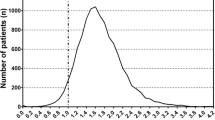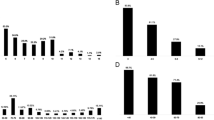Abstract
Background and Purpose:
Exact, prehospital, on-scene grading is crucial in patients with life-threatening injuries. For blunt trauma, early patient grading continues to represent a challenge. In Europe, the ratio between heart rate and blood pressure (Shock Index [SI]) was frequently used in the 1980s, but was later discarded as irrelevant due to improved rescue times. The current study reevaluates the usefulness of this index based on the German Trauma Registry.
Methods:
Patients documented in the German Trauma Registry between 1993 and 2001 were investigated. The registry lists patients with multiple injuries. From these patients, inclusion criteria were multiple injuries with complete on-scene documentation. A subgroup analysis was performed for patients who have minor injuries (Injury Severity Score [ISS] < 16, no requirement of intensive care therapy) and patients who died in the emergency room (ER). The association between pathologic values of the SI and later complications (organ failure and death) was investigated. Also, associations between pathologic shock indices and the clinical diagnoses as made by the physician on scene and special injuries diagnosed after hospital admission were calculated.
Results:
6,346 patients were included in the study and demonstrated the following demographic parameters: mean age 33.4 (16–81) years, male gender 76.4%; mean admission Glasgow Coma Scale (GCS) 9.8 (4–15) points, mean alert time 14.4 (6.3–73) min, mean rescue time 43.5 (22–91) min; mean prehospital crystalloids 954.9 (200–4,300) and colloids 773 (150–3,100). A receiver operating characteristic (ROC) analysis regarding the association between a score and the likelihood of complications was calculated and provided the following results: Revised Trauma Score (RTS), 0.633; SI, 0.684; pulse rate, 0.579; blood pressure, 0.564; respiratory rate, 0.377. An odds ratio was calculated, describing the likelihood of organ failure in specific patient subgroups. The highest values were obtained for patients who died in the ER (6.3), patients in whom the cause of death was hemorrhagic shock (6.1), and patients who sustained predominantly abdominal (5.3) and pelvic injuries (4.5).
Conclusion:
The data of this study supports previous findings that the ratio between pulse and systolic blood pressure is sensitive in detecting shock states in patients with multiple injuries. In the current population, the value of the SI as a field screening tool was better in patients who died of shock and those who sustained abdominal or pelvic injuries when compared with those who had extremity fractures only. It was improvable by adding the presumed major clinical prehospital diagnosis. The score is easily accessible and may be used for estimation of the blood volume status on scene.
Similar content being viewed by others
Author information
Authors and Affiliations
Corresponding author
Rights and permissions
About this article
Cite this article
Grimme, K., Pape, H.C., Probst, C. et al. Calculation of Different Triage Scores Based on the German Trauma Registry. Eur J Trauma 31, 480–487 (2005). https://doi.org/10.1007/s00068-005-2026-8
Received:
Accepted:
Issue Date:
DOI: https://doi.org/10.1007/s00068-005-2026-8




